Upgrading Web Equipment Pattern 1908 - Royal Navy
 The British Armed Services had rejected the concept of a Machine Carbine back in the 1930s. When the Second World War started, thoughts of such a weapon surfaced again.
The British Armed Services had rejected the concept of a Machine Carbine back in the 1930s. When the Second World War started, thoughts of such a weapon surfaced again.
It was not long before an appreciation dawned of the German Army’s commitment to the MP38, the so-called “Schmeisser” and with it, an urgent requirement for a counterpart. The Thompson Machine Carbine (T.M.C.) was the only readily available M.C., though it was apparently not the “weapon of choice”. The Finnish Suomi design apparently had the greatest appeal. Unfortunately the Finns were then fighting Russia, which precluded obtaining supplies. Orders for the T.M.C. were placed in February 1940, too late in the day, as with Dunkirk came the fear of imminent invasion and a requirement for even more of what was in very short supply. The Thompson was old and heavy, more importantly it cost $225 (c. £56 !), which understandably led to moves for an in-house design. To save time the German Bergmann MP28 was “reverse engineered” into the Lanchester Machine Carbine, a weapon of some quality, bearing in mind what was to follow as the second home grown gun!
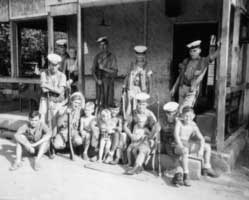 At £14 each, the initial batch ordered in 1940 represented a considerable saving, but it was only fractionally lighter than the Thompson. In wartime, quality has to be sacrificed in favour of simplicity and cheapness. The Lanchester was neither. Accordingly, orders were placed in 1941 for the Sten. It was cheap; it was light and was so simple that a huge number of ordinary engineering companies could be made sub-contractors to the arms industry. Early Stens cost around £10, which sank to between £3 - £5 once it had been properly production engineered to the bare essentials.
At £14 each, the initial batch ordered in 1940 represented a considerable saving, but it was only fractionally lighter than the Thompson. In wartime, quality has to be sacrificed in favour of simplicity and cheapness. The Lanchester was neither. Accordingly, orders were placed in 1941 for the Sten. It was cheap; it was light and was so simple that a huge number of ordinary engineering companies could be made sub-contractors to the arms industry. Early Stens cost around £10, which sank to between £3 - £5 once it had been properly production engineered to the bare essentials.
The Lanchester magazines had a capacity of 50 rounds and a Pouch to carry 3 of these was produced. Provision was made for a magazine loading tool, which meant left and right were different Pouches. Orders had been initiated jointly by the Admiralty and the Air Ministry. In the event most went to the Navy, with the RAF using the Sten. Where the Pouches for the R.A.F. were compatible with Patt. ’25 W.E., the Royal Navy’s Pouches were fitted up for use with Patt. ’08 W.E..
The photograph at the beginning of this section is of a member of the crew of H.M.A.S. Shropshire at Scapa Flow, 16 Aug 43, on the occasion of an inspection by HM The King. Taken from H.M.A.S. Mk III (page 31) published for The Royal Australian Navy by Australian War Memorial, Canberra, A.C.T. 1944, and provided by Graham Tweeddale. The photo at right above shows sailors of H.M.S. Cumberland, in the Far East, 1945. The two at the rear right have Lanchesters, and are wearing either W.E. Patt. '19 or W.E. Patt. with paired left-hand Lanchester magazine pouches. Their Pouches appear to be either made or converted for Patt. '37, as no diagonal pack support straps can be seen. Also note that the left-hand man has his Patt. ’07 Bayonet (Bayonet, No. 1, Mark 1) fixed. Despite Patt. ’08 W.E. being obsolete, the rest of the group are wearing it! From the Chris Pollendine Collection.
POUCH, MAGAZINE, LANCHESTER MACHINE CARBINE, LEFT, PATTERN 1908
POUCH, MAGAZINE, LANCHESTER MACHINE CARBINE, RIGHT, PATTERN 1908 With tool pocket
POUCH, MAGAZINE, CARBINE, MACHINE, LANCHESTER, LEFT, PATTERN 1908
POUCH, MAGAZINE, CARBINE, MACHINE, LANCHESTER, RIGHT, PATTERN 1908 With tool pocket

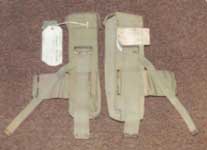 The top pair of nomenclatures are taken from the Sealed Working Patterns illustrated, but with the obvious addition of the Pattern Year. The second pair is from a 1943 Admiralty Fleet Order (A.F.O.). They ought to have been – more correctly - a “Carrier, Magazine, L.M.C.”, as they had internal divisions. The standard Patt. ’37 envelopes were here extensively modified. The hook patches were extended rearwards, one hook at the rearward end and a securing band – Patt. ’08 Cartridge carrier style - in the centre. The “C” hook at the waistbelt buckle end was set back from the edge of the Pouch.
The top pair of nomenclatures are taken from the Sealed Working Patterns illustrated, but with the obvious addition of the Pattern Year. The second pair is from a 1943 Admiralty Fleet Order (A.F.O.). They ought to have been – more correctly - a “Carrier, Magazine, L.M.C.”, as they had internal divisions. The standard Patt. ’37 envelopes were here extensively modified. The hook patches were extended rearwards, one hook at the rearward end and a securing band – Patt. ’08 Cartridge carrier style - in the centre. The “C” hook at the waistbelt buckle end was set back from the edge of the Pouch.
The standard Tab, web, 2 in., with brass tip and buckle, 12 3/4 in. was stitched to the rear face, the Brace buckle being considerably below the top of the Pouch, just as with the Patt. ’37 compatible version. However, where the Patt. ’37 version had a two-piece, press-fastened strap horizontally across the Pouch top, these have a closed loop, through which the Brace had first to be passed through. They served to tie the Pouch closer to the chest. The standard “diagonal strap” was fitted, as per Patt. ’08 Cartridge carriers. The left Pouch is maker marked "B Ltd", an unknown maker, and dated 1941. The right is maker marked "MW&S Ltd" (M. Wright & Sons) and dated 1941. From the John Bodsworth Collection. Photographs © John Bodsworth 2012.
POUCH, MAGAZINE, LANCHESTER MACHINE CARBINE, LEFT, CONVERTED
POUCH, MAGAZINE, LANCHESTER MACHINE CARBINE, RIGHT, CONVERTED With tool pocket
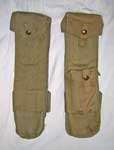
 The nomenclature is speculative, as no naval Stores Vocabularies have been seen. After 1941, possibly in late 1941 (the date has still to be confirmed with naval documentation), the Royal Navy made Patt. ’08 obsolete. This was probably to fall in line with the Army in using a single design in service, namely Patt. ’37 W.E. The R.A.F. had changed to blue-grey Patt. ’37 in July 1941.
The nomenclature is speculative, as no naval Stores Vocabularies have been seen. After 1941, possibly in late 1941 (the date has still to be confirmed with naval documentation), the Royal Navy made Patt. ’08 obsolete. This was probably to fall in line with the Army in using a single design in service, namely Patt. ’37 W.E. The R.A.F. had changed to blue-grey Patt. ’37 in July 1941.
Admiralty Fleet Order (A.F.O.) 4187, dated (approved?) 9 September 1943, authorised a modification, Pattern 1908 W.E. then being obsolete in the Royal Navy. The required fittings were to be substituted to enable compatibility with Patt. ’37. From the front, there was no change in the Pouch itself, but every rear fitting was to be removed. The closed Brace loop was changed to a press-studded loop, which facilitated easier assembly than the Patt. ’08 version. The 2-inch Brace buckle and its extension tab were cut-off, together with the diagonal strap. In its place was a 4-bar buckle (Buckle, brass, 1 inch, with loop), on a chape cum fairlead, which allowed the Brace to pass down through the fairlead. The broad extension strap, carrying the 3-inch “C” hooks was removed, exposing the original stitching guide marks for a 3-inch patch. A complete assembly of a pair of 2.25-inch “C” hooks, on a webbing patch, was then substituted. Originally, the “C” hooks nearest the Waistbelt buckle were set back from the vertical edge of the Pouch. The new patch placed both smaller “C” hooks slightly beyond the vertical edges. The tool pocket was still intended to be on the right-hand Pouch, though the converted ones were now not “handed”. The examples shown above left are maker marked "M" and dated 1943. From the Karkee Web Collection.


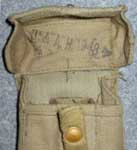 Another converted right-hand Pouch. Note the fabrication marks showing where the original '08 fittings were placed, as well as the scars on the webbing where the old bits were removed, which are particularly well shown on this example. This Pouch is maker marked "J. & A.H." (J. & A. Hillman) and dated 1943. From the Graham Tweeddale Collection. Photographs © Graham Tweeddale, 2012.
Another converted right-hand Pouch. Note the fabrication marks showing where the original '08 fittings were placed, as well as the scars on the webbing where the old bits were removed, which are particularly well shown on this example. This Pouch is maker marked "J. & A.H." (J. & A. Hillman) and dated 1943. From the Graham Tweeddale Collection. Photographs © Graham Tweeddale, 2012.
In addition to the converted Patt. '08 Pouches, from 1941 onwards, Pouches, Magazine, Lanchester Machine Carbine were purpose made for use with W.E. Pattern 1937. Both these and the converted Pouches are discussed on the Patt. '37 Associated Equipment - Attached page.
Carrier, entrenching tool, head

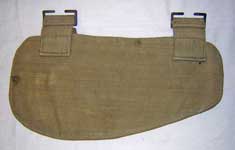
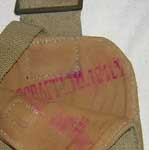 This interesting variant is identical to the first issue Entrenching tool carrier issued withW.E. Patt. '37 , except that is has 2-inch buckled chapes instead of the 1-inch ones found on Pattern '37. This example is maker marked "BAGCRAFT LTD." and dated 1941. From the Karkee Web Collection.
This interesting variant is identical to the first issue Entrenching tool carrier issued withW.E. Patt. '37 , except that is has 2-inch buckled chapes instead of the 1-inch ones found on Pattern '37. This example is maker marked "BAGCRAFT LTD." and dated 1941. From the Karkee Web Collection.
The Implement, intrenching, Patt. ’08 and its associated Head and Helve carriers were declared obsolete by List of Changes entry §25979, dated 6th September 1923. Although the L. of C. entry does not state this obsolescence applied to Land Service only, the L. of C. does state that this action was taken in accordance with Army Order 267/1923. In 2009, a small lot of second issue Patt. '08 Head carriers were found in Malta. Many (but not all) of them were naval marked and dated 1928, which strongly suggests that the Royal Navy continued to use the Entrenching tool, even after the army had declared it was no longer required. The Tool was reintroduced by L. of C. §B5409 in 1941, as the Implement, entrenching, Patt. ’37. Neither of the Carriers shown here is naval marked, so inclusion on this page has to be speculative only. However, it's worth noting that the Bagcraft example shown above was acquired from the same Maltese source as the 1928 naval marked Carrier, and that not all of the 1928 dated Carriers were naval marked. Given those facts, we have included it here, with the caveat that more evidence is needed to be certain of its naval use. Readers - can you help?
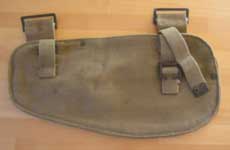
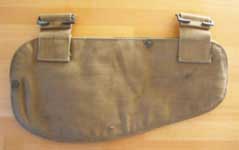
 Another example, maker marked "M.E. Co." and dated 1941. From the Richard Knight Collection, photos © Richard Knight 2012.
Another example, maker marked "M.E. Co." and dated 1941. From the Richard Knight Collection, photos © Richard Knight 2012.